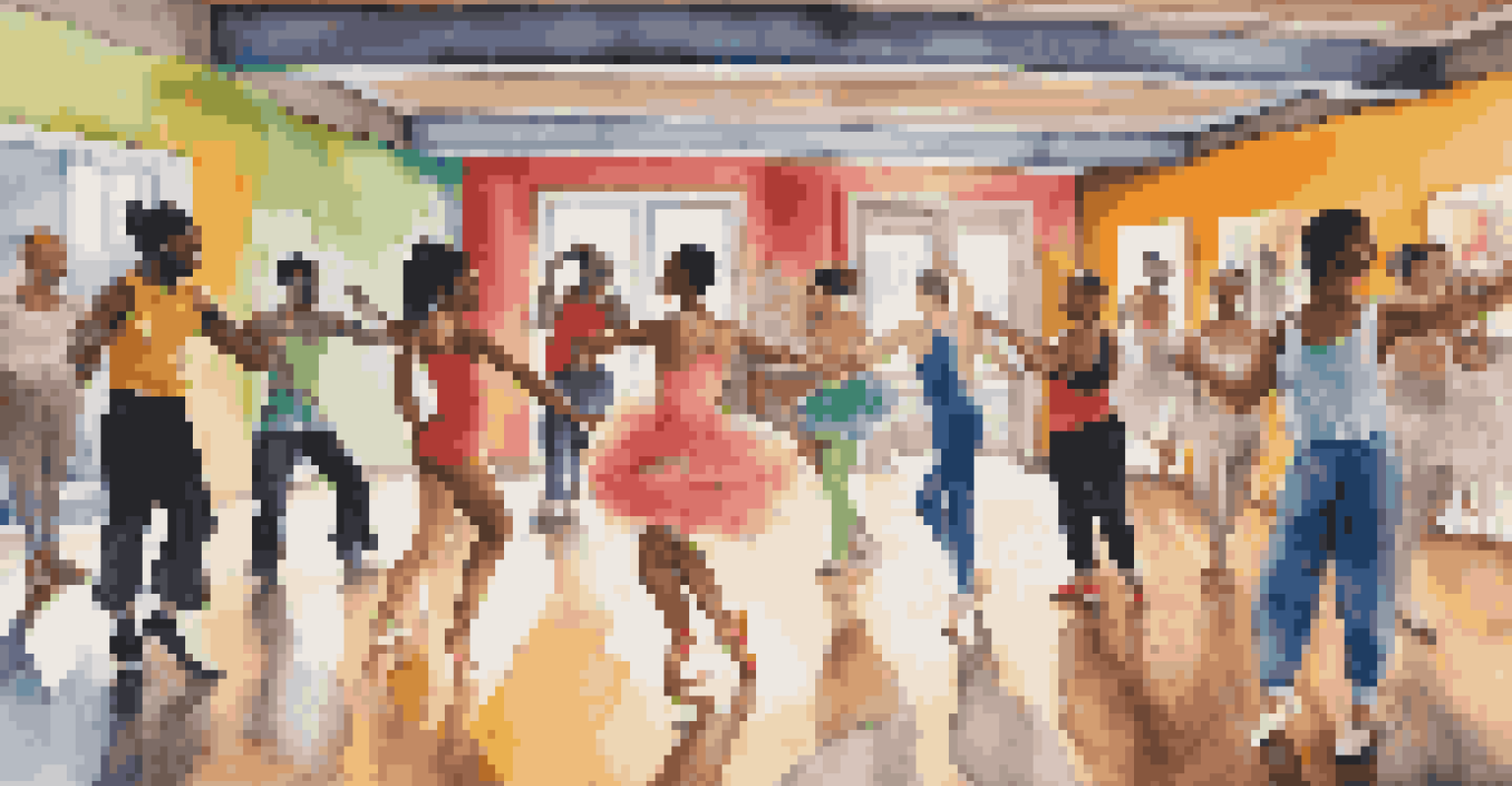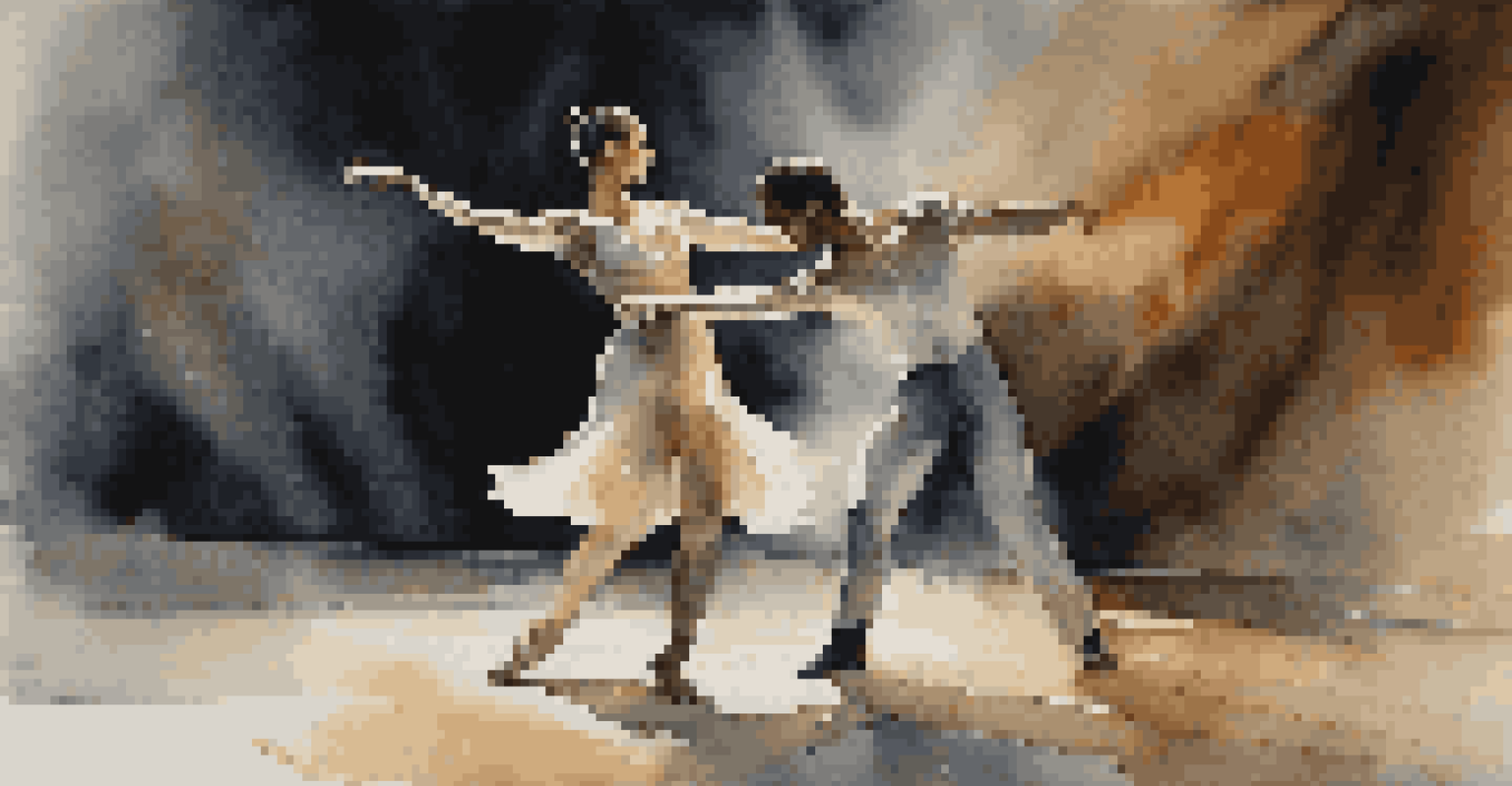The Importance of Trust in Dance Collaborations and Partnerships

Understanding Trust in Dance Partnerships
Trust is the foundation of any successful dance collaboration. It allows dancers to feel safe and supported, enabling them to express their creativity without fear of judgment. In a partnership, trust builds a solid relationship where both parties can rely on each other to bring their best selves to the project.
Trust is the foundation of all relationships, and that includes dance partnerships.
When dancers trust one another, they can explore new ideas and push boundaries, resulting in innovative choreography. This mutual confidence also fosters a sense of belonging, making it easier for dancers to communicate openly about their visions and intentions. Ultimately, trust transforms a simple partnership into a dynamic creative synergy.
For example, consider a duet where one dancer lifts another. This requires not just physical strength but a deep level of trust. The dancer being lifted must believe that their partner will support them, while the lifter must trust their own abilities and instincts. Such trust enables breathtaking performances that captivate audiences.
Building Trust Through Communication
Effective communication is key to establishing trust in any relationship, including dance partnerships. Dancers should feel comfortable discussing their ideas, concerns, and expectations openly. This dialogue helps to clarify intentions and can prevent misunderstandings that might otherwise erode trust over time.

Regular check-ins and collaborative discussions can help establish a rhythm in communication. By sharing feedback and affirming each other's contributions, dancers can create a supportive environment. This openness not only builds trust but also nurtures a collective vision for the project.
Trust is Key in Dance Partnerships
Trust serves as the foundation for successful dance collaborations, allowing dancers to express their creativity and explore new ideas.
Imagine a rehearsal where one dancer suggests a new move. If the suggestion is met with enthusiasm and constructive feedback, trust is reinforced. However, if the idea is dismissed without discussion, it can lead to feelings of insecurity. Thus, fostering a culture of communication is vital for trust to flourish.
The Role of Vulnerability in Dance
Vulnerability plays a crucial role in building trust among dancers. When performers allow themselves to be vulnerable, they open the door to authentic connections and deeper collaborations. It takes courage to share personal stories and emotions through dance, and this sharing can strengthen bonds between partners.
Creativity takes courage.
For instance, a dancer might share their struggles with a particular movement, leading to a more empathetic understanding between partners. This shared vulnerability can create a space where both dancers feel seen and respected, encouraging them to take creative risks together. Ultimately, it enhances the overall quality of their work.
By embracing vulnerability, dancers can inspire one another and cultivate trust. This dynamic often results in more powerful performances, as the audience can sense the genuine connection between the dancers. Trust and vulnerability together create a magical synergy that resonates on stage.
Trust and Creative Freedom
In a trusting environment, dancers can explore their creativity without fear. When partners feel secure in their relationship, they are more likely to take risks and experiment with new styles or techniques. This creative freedom is essential for artistic growth and can lead to groundbreaking performances.
For example, in a collaborative project, one dancer might suggest an unconventional movement. If their partner trusts their instincts and abilities, they can dive into the idea without hesitation. This exploration can lead to unexpected and exciting outcomes that elevate the entire piece.
Communication Builds Trust
Open dialogue among dancers helps clarify intentions and fosters a culture of support, reinforcing trust within the partnership.
Moreover, this freedom often encourages dancers to support each other's ideas, fostering a sense of teamwork. When each dancer feels empowered to contribute, it enriches the collaboration and enhances the final performance. Trust, therefore, is not just a safety net; it’s a catalyst for creativity.
Trust in Diverse Dance Collaborations
In today’s dance landscape, collaborations often involve diverse styles and backgrounds. Trust becomes even more crucial in these situations, as dancers navigate different artistic languages and approaches. Establishing trust allows them to blend their unique perspectives harmoniously.
For instance, a hip-hop dancer partnering with a ballet dancer may face challenges due to their distinct techniques. However, by fostering trust, they can appreciate each other's strengths and create a seamless fusion of styles. This collaboration highlights how trust can bridge the gap between different dance forms.
Moreover, embracing diversity through trust can lead to richer artistic expressions. When dancers from various backgrounds collaborate, they bring unique narratives and movements that can deeply resonate with audiences. Trust enables this exploration and celebrates the beauty of diversity in dance.
Overcoming Challenges to Build Trust
While trust is vital, it doesn’t always come easily—especially after setbacks or conflicts. Dancers may face challenges that test their faith in one another, such as miscommunication or differing artistic visions. However, addressing these challenges head-on can ultimately strengthen trust.
For example, if a disagreement arises during choreography, addressing it openly rather than letting it fester is crucial. This proactive approach demonstrates a commitment to the partnership and a willingness to work through difficulties. By resolving conflicts, dancers can emerge stronger and more connected than before.
Vulnerability Enhances Collaboration
Embracing vulnerability in dance creates authentic connections, allowing partners to take creative risks and produce powerful performances.
Additionally, acknowledging past mistakes or misunderstandings can foster forgiveness and growth. Trust is often rebuilt through shared experiences and a mutual desire to enhance the collaboration. By facing challenges together, dancers can develop a resilient bond that stands the test of time.
The Lasting Impact of Trust in Dance
The importance of trust in dance collaborations extends beyond individual projects; it leaves a lasting impact on dancers’ careers. Strong partnerships built on trust often lead to future collaborations, creating a network of support within the dance community. This ripple effect can significantly enhance a dancer's opportunities.
Moreover, when dancers establish a reputation for being trustworthy collaborators, they become sought-after partners in the industry. This reputation can open doors to new projects, performances, and creative ventures. Trust, therefore, not only enhances immediate collaborations but also contributes to long-term success.

Ultimately, the trust built in dance partnerships cultivates a positive and nurturing environment that encourages artistic exploration. As dancers continue to collaborate and grow together, they contribute to a vibrant and innovative dance landscape that inspires others. This legacy of trust is invaluable in the world of dance.